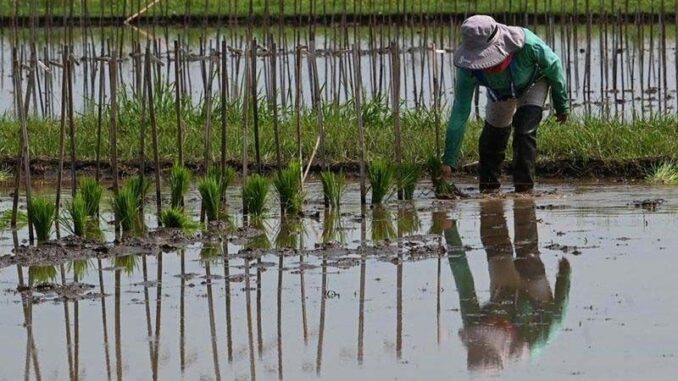
MANILA, Philippines — The Department of Agriculture (DA) reported on Wednesday, October 23, that rice stocks are enough to last through the rest of 2024, despite agricultural losses brought by Severe Tropical Storm “Kristine” (international name: Trami).
Agriculture Spokesperson Arnel de Mesa, in an interview with state media PTV, said that the country is not “worried” about its rice supply, pointing to rice importation as a key factor.
“It is because of rice imports that have arrived and are expected to arrive. Based on historical trends, our stock inventory can still last up to 100 days after the end of the year. So, we are not worried about our supply,” De Mesa said in a mix of English and Filipino.
In a press release on Wednesday, the agency announced that the country anticipates a rice supply of 3.83 million metric tons (MMT) by the end of the year, sufficient to meet 100 days of consumption. As of October 14, the country has received 3.57 MMT of rice imports.
Meanwhile, the agency projects annual palay production to reach 19.41 MMT, equivalent to 12.69 MMT of milled rice. This is a decrease from the total palay output of 20.06 MMT in 2023.
A metric ton is equivalent to 1,000 kilograms.
Damages. According to their initial assessment, the DA estimates that rice and corn plantations in the Bicol Region, particularly Camarines Sur and Camarines Norte, have suffered agricultural damage amounting to P9.75 million.
Severe Tropical Storm Kristine has impacted 234 farmers and 209 hectares of agricultural land, with two-thirds of this area expected to be irreparable. Projected production losses include 591 metric tons of palay and 7.50 metric tons of corn.
Response. The DA Regional Field Offices (RFO) are actively monitoring damage, issuing advisories to local stakeholders, conducting price assessments and mobilizing logistical support for affected communities.
The agency is also providing assistance by distributing agricultural inputs, including rice, corn, vegetable seeds, and biologics or medicine for livestock, across Central Luzon, Calabarzon, Mimaropa, Bicol, Eastern Visayas, and Caraga.
Farmers can access loans of up to P25,000 through the Agricultural Credit Policy Council’s Survival and Recovery Loan Program, with a repayment period of up to three years and no interest.
Financial reimbursement from the Philippine Crop Insurance Corporation will also be available for insured farmers affected by agricultural losses.
Although the DA is not worried about the country’s rice stocks despite agricultural damages, farmers are more concerned about their ability to recover financially from anticipated lower palay prices and damaged plantations.
Concerns over declining palay prices
Farmers in the Bicol region are troubled about the decline in palay prices, saying that current rates, which they believe may drop to P15 per kilogram, will not yield any profit for them.
This situation is exacerbated by the storm’s damage to their rice plantations, which were supposed to be ready for harvest in November.
According to the Philippine Statistics Authority, the average farmgate price of palay in the country by the end of the third quarter stands at P23.41 per kilogram, a decrease from P24.65 per kilogram in the second quarter.
The Bicol Region also has one of the lowest average farmgate prices for palay, with a kilogram priced at only P21.85.
In a statement on Thursday, October 24, Amihan National Federation of Peasant Women (Amihan Women) called for an increase in farmgate prices of palay, saying that farmers are struggling to bring food to the table with debts incurred from their agricultural investments on top of low earnings.
A Laguna-based farmer shared with the peasant group that they typically require a capital of P60,000 to P70,000 to cultivate one hectare of rice land.
“Bago [ito] mahinog, mabubulok na ang ilalim dahil sa lubog sa tubig, babaratin kami at posibleng bilhin lang sa amin ng P10 kada kilo ang palay,” the farmer said.
(Before it ripens, the bottom will start to rot due to being submerged in water, so we might be bought for just P10 per kilo for the palay.)
The farmer estimates that their earnings will be only one-fourth of what they could have made because of Kristine.
Kilusang Magbubukid ng Pilipinas on Wednesday said that farmers have not even recovered from Typhoon Enteng which ravaged the country in September.
“Dagdag pa rito ang mabagal at di-sapat na tugon ng pamahalaan para alalayan ang mga apektadong magsasaka,” KMP Chairperson Danilo Ramos said in a statement.
(On top of the disaster is the government’s slow and inadequate response to assist affected farmers.)
As of 5 p.m. on Thursday, several provinces in Northern Luzon were under Signal No. 3, with Kristine located over the coastal waters of Ilocos Sur. Most regions in Luzon and Visayas are under Signal No. 2 and Signal No. 1.
Severe Tropical Storm Kristine is anticipated to exit the Philippine area of responsibility (PAR) by Friday, October 25.


Be the first to comment